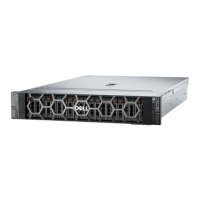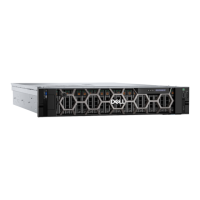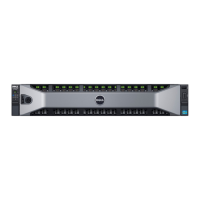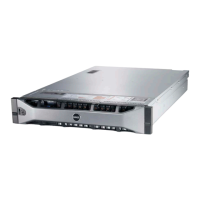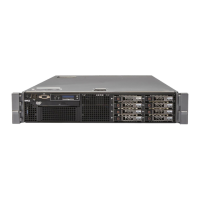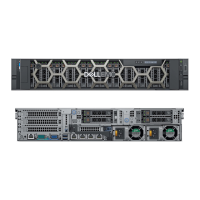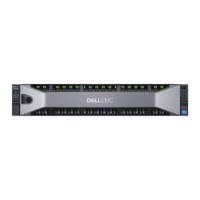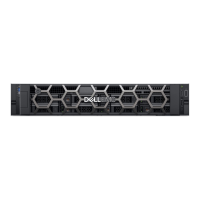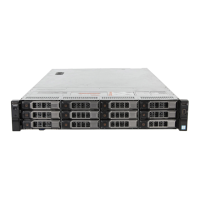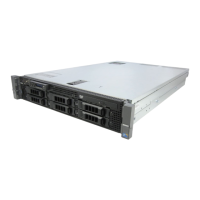Do you have a question about the Dell PowerEdge R7625 and is the answer not in the manual?
Details the components and features visible on the front panel of the Dell PowerEdge R7625 server.
Describes the indicators, buttons, and connectors on the left control panel of the system.
Details the ports and controls located on the right control panel of the server.
Illustrates and describes the ports, panels, and slots available on the rear of the system.
Provides an illustration and list of internal components within the Dell PowerEdge R7625 server.
Explains the location and purpose of system information labels, including Service Tag and Express Service Code.
Provides detailed measurements for the system's chassis in millimeters and inches.
Details the supported processors and the number of processors the system can accommodate.
Lists the specifications for the system's Power Supply Units (PSUs), including wattage and voltage.
Outlines the supported memory types, ranks, capacities, and speeds for optimal system performance.
Details the specifications for various ports and connectors on the system, including NIC and USB.
Provides operating and non-operational environmental parameters for the system.
Outlines the basic steps required for initial system setup and hardware installation.
Explains how to configure the Integrated Dell Remote Access Controller (iDRAC) for system management.
Lists the resources and documentation available for installing a supported operating system.
Details how to access and configure system settings using System Setup, including BIOS.
Provides guidance on configuring system memory and processor-related options in BIOS.
Covers configuring boot modes, boot order, and network interface settings.
Explains how to configure system security features like passwords and Secure Boot.
Essential safety guidelines and prerequisites before performing any system component maintenance.
Lists the necessary tools required for component removal and installation procedures.
Procedures for removing and installing the system's outer cover for internal access.
Instructions for removing and installing cooling fans and air shrouds for thermal management.
Detailed steps for removing and installing the processor and its associated heat sink.
Guidelines for installing and removing expansion cards and their corresponding riser modules.
Procedures for removing and installing power supply units and their blanks.
Instructions for removing and installing the main system board.
Identifies and describes the various connectors on the system board.
Details the function and configuration of system board jumpers.
Provides instructions on how to clear system and setup passwords using the password jumper.
Explains the meaning of status LED indicators on the system front panel.
Describes system health and system ID indicator codes for status monitoring.
Details the drive status indicator codes indicating drive activity and health.
Introduces the Dell Embedded System Diagnostics (ePSA) for hardware testing.
Steps to run system diagnostics using the Boot Manager utility.
Steps to run system diagnostics using the Dell Lifecycle Controller.
Provides information on how to contact Dell support for assistance.
Explains how to use the Quick Resource Locator (QRL) for system information.
Details the benefits and setup of Dell SupportAssist for automated technical support.
Lists various documents and resources available for system setup and management.
Details the components and features visible on the front panel of the Dell PowerEdge R7625 server.
Describes the indicators, buttons, and connectors on the left control panel of the system.
Details the ports and controls located on the right control panel of the server.
Illustrates and describes the ports, panels, and slots available on the rear of the system.
Provides an illustration and list of internal components within the Dell PowerEdge R7625 server.
Explains the location and purpose of system information labels, including Service Tag and Express Service Code.
Provides detailed measurements for the system's chassis in millimeters and inches.
Details the supported processors and the number of processors the system can accommodate.
Lists the specifications for the system's Power Supply Units (PSUs), including wattage and voltage.
Outlines the supported memory types, ranks, capacities, and speeds for optimal system performance.
Details the specifications for various ports and connectors on the system, including NIC and USB.
Provides operating and non-operational environmental parameters for the system.
Outlines the basic steps required for initial system setup and hardware installation.
Explains how to configure the Integrated Dell Remote Access Controller (iDRAC) for system management.
Lists the resources and documentation available for installing a supported operating system.
Details how to access and configure system settings using System Setup, including BIOS.
Provides guidance on configuring system memory and processor-related options in BIOS.
Covers configuring boot modes, boot order, and network interface settings.
Explains how to configure system security features like passwords and Secure Boot.
Essential safety guidelines and prerequisites before performing any system component maintenance.
Lists the necessary tools required for component removal and installation procedures.
Procedures for removing and installing the system's outer cover for internal access.
Instructions for removing and installing cooling fans and air shrouds for thermal management.
Detailed steps for removing and installing the processor and its associated heat sink.
Guidelines for installing and removing expansion cards and their corresponding riser modules.
Procedures for removing and installing power supply units and their blanks.
Instructions for removing and installing the main system board.
Identifies and describes the various connectors on the system board.
Details the function and configuration of system board jumpers.
Provides instructions on how to clear system and setup passwords using the password jumper.
Explains the meaning of status LED indicators on the system front panel.
Describes system health and system ID indicator codes for status monitoring.
Details the drive status indicator codes indicating drive activity and health.
Introduces the Dell Embedded System Diagnostics (ePSA) for hardware testing.
Steps to run system diagnostics using the Boot Manager utility.
Steps to run system diagnostics using the Dell Lifecycle Controller.
Provides information on how to contact Dell support for assistance.
Explains how to use the Quick Resource Locator (QRL) for system information.
Details the benefits and setup of Dell SupportAssist for automated technical support.
Lists various documents and resources available for system setup and management.
| Maximum Processors | 2 |
|---|---|
| Cores per Processor | Up to 96 |
| Memory Type | DDR5 |
| Maximum Memory | 6TB |
| RAID Support | Yes |
| Form Factor | 2U Rack |
| Processor | AMD EPYC 9004 Series |
| Memory Slots | 24 |
| Storage | Up to 24 x 2.5" drives |
| Storage Controller | PERC H755, H755N |
| RAID Controllers | PERC H755, H755N, H355 |
| GPU Support | Up to 3 double-width GPUs |
| Network Options | 1 GbE, 10 GbE, 25 GbE, 100 GbE options available |
| Network Controller | Broadcom 5720, Intel X550, Mellanox ConnectX-6 |
| PCIe Slots | Up to 8 |
| Operating System Support | Windows Server, Red Hat Enterprise Linux, SUSE Linux Enterprise Server, VMware ESXi |
| Power Supply | 800 W Platinum, 1100 W Titanium, 1400 W Platinum, 1800 W Platinum |
